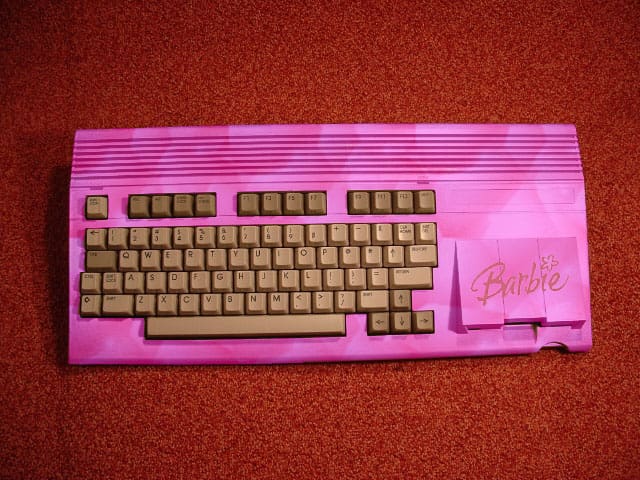When it comes to the Commodore C65, the discussion quickly becomes unobjective. On the one hand there are the fans who see it as the holy grail, on the other hand there are the people who call it a regicide and Commodore’s nail in the coffin. As is so often the case, the truth probably lies somewhere in between. Here is a summary of the usual prejudices, questions and misinformation.
What is a C65 worth?
It is a collector’s item that has risen in value in recent years from an initial EUR 600 to almost tens of times that amount. Surprisingly, the condition and functionality are secondary. Worn, defective devices reach almost the price of flawless specimens. For the user, see „The C65 is useless“.
The C65 is useless!
The Commodore C65 is just as useless as any old home computer today. Whether such a box runs 500, 5,000 or 500,000 programmes: They are all hopelessly nostalgic and useless. None of them have any use that a modern computer could not fulfil.
How useless are the countless extensions for the C64? The super CPU, for example, doesn’t fulfil any useful purpose, every navigation device for 50 euros has more computing power and practical use.
From a C64 fanboy’s point of view, the C65 is just as useless as a C128. But who cares? ;)
There was no 1565 floppy.
Well, there were as many or as few of them as there were C65s. Sure, this external 3.5″ floppy is much rarer than the computer itself, but it did exist. Enno Conner’s C65 with 1565 went for around 81,000 euros over the virtual counter on eBay at the end of 2017. Although most C65s do not have a socket for connecting the floppy on the motherboard, it was actually provided and therefore stubbornly blocks device 9 – even in C64 mode!
There were no expansions for the C65.
There was a RAM extension called C-1990.
The C65 is terribly slow!
It is blazingly fast and represented the pinnacle of 8-bit home computers. Like the Amigas, the C65 had special custom chips that raised its performance far above any other 8-bit device of the era. It goes without saying that loading Amiga images took longer than on the Amiga, as these were 16/32-bit devices.
The C65 is full of 8-bit bottle necks!
It’s an 8-bit system, even if the CPU has some 16-bit extensions.
The C65 was far too expensive!
The target price was DM 600 with a floppy drive, which was exactly the same as a C64 with 1541, while the Amiga 500 cost DM 1,000 at the time.
The C65 was intended to compete with the PCs.
According to internal documents, it was intended to revitalise the home computer market. It was the declared successor to the Commodore 64 and was never aimed at companies, but at private users. The lack of a numeric keypad on the keyboard is a clear indication of this. Even if the performance was comparable to that of a PC at the time, the entire concept of the computer was aimed at home users. However, the Amigas (x.000 series) competed against the PCs and were at times years ahead of them.
The C65 would have rivalled the Amiga.
In fact, the Amiga 500/600 was a home computer. The mistake was rather to want to establish the Amiga series in the home computer sector and in the professional sector without differentiating the devices from the performance. This only came with the further development of the Amiga hardware. By then, however, this platform already had the reputation of being a toy and a freak machine for artists and media professionals.
If the Commodore 65 had replaced the 64 and the Amiga without any ifs and buts, it would have been a success. However, as the A500 already existed and the C65 offered less performance, replacing the Amiga 500 with a weaker machine would have been absurd.
The Commodore 65 would have been the ideal upgrade for C64 owners, as it could have used its peripherals and software. Of course, this did not work on an Amiga.
Virtually no programmes run on the C65!
With a few exceptions, all C64 application programmes run on the C65. But it’s a different story with games. It is not a question of the age of the game, but rather whether the game was programmed according to the system specifications of the C64. Games that use a lot of the illegal opcodes are less likely to run. The problem also exists with the Aldi-C64, the C64G.
Naturally, there were hardly any programmes for the C65 mode, but this is not surprising when you consider that the prototypes that are still in circulation today were produced for software developers and editorial offices at the time so that they could examine the device before the start of series production – which never happened – and develop software for it.
Even the C65 software only works on individual devices!
There may be individual devices on which one or other C65 programme causes problems. This is due to the different ROM and chip versions.
Unlike the other C= computers, the C65 has a BASIC from Microsoft.
MS grew up with the sale of BASIC. Every Commodore computer had a BASIC from Microsoft. These interpreters adapted to the devices were initially licensed for a one-off payment(!), which is why Commodore did not have to mention MS copyright in the switch-on message, or used its own copyright. From 1985, the Commodore C128 already displayed the MS copyright when it was switched on.
Pictures of the Commodore 65:
{gallery}C65 pictures{/gallery}
